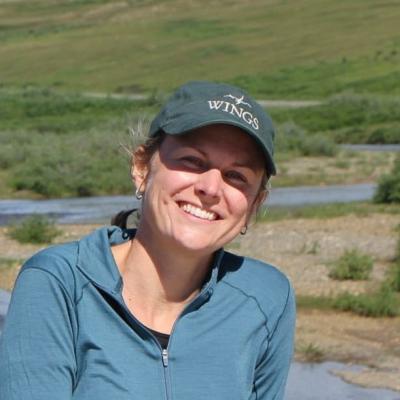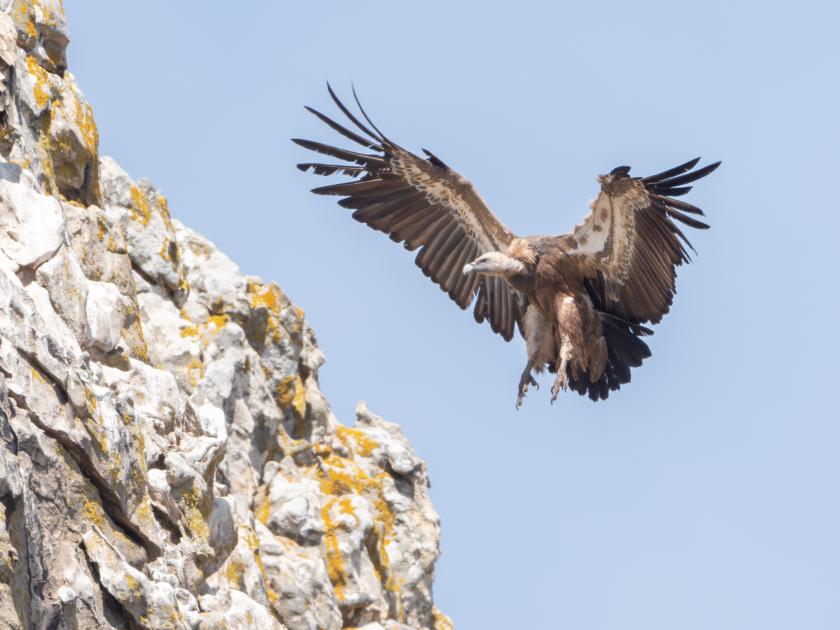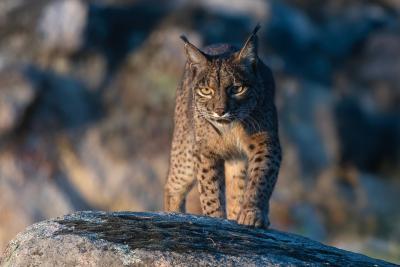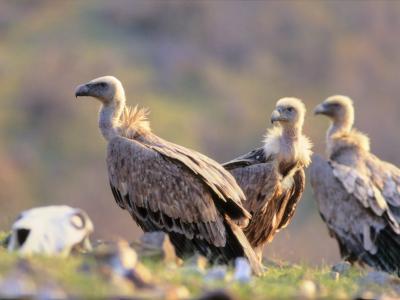Spain in Autumn
-
Sep 7-17, 2025
Oli Reville and a local leader
-
Sep 7-17, 2026
Oli Reville and a local leader
2025
Single Room Supplement $550
2026
Tour Price to be Determined
2025
Single Room Supplement $550
2026
Tour Price to be Determined
This exciting tour focuses on the country’s most southern region, Andalusia, an area of great contrast, with vast plains, towering mountains, stunning coastlines, and rolling countryside with attractive pueblos blancos (white towns) dotting the landscape. We’ll explore these habitats and visit the Strait of Gibraltar, Western Europe’s primary migration flyway looking for White-headed Duck, Great Bustard, and Northern Bald Ibis among many others.
We’ll experience the spectacle of migration with some 25 species of shorebird, including the striking Collared Pratincole, and 20 species of raptor, including Spanish Imperial Eagle.
We’ll also offer a fantastic cetacean-watching trip off the coast of Cádiz province, with a good mix of seabirds and stunning views of Morocco across the Strait of Gibraltar as a bonus.
This tour is perfect for travelers looking to enjoy the wonderful weather, culture and food of Southern Spain and the impressive spectacle of the European fall migration. Typically, we can expect to encounter 170-190 bird species along the way.
Day 1: The tour begins this evening in Seville with a welcome meal at our hotel. Night in Seville.
Day 2: Our first day of birding will begin by exploring the vast expanses of Brazo del Este. This important wetland area along the east bank of the Guadalquivir River is a birding paradise with a huge array of species on offer, and we’ll make our first efforts with species such as Marbled and White-headed Ducks, Red-knobbed Coot, and Spanish Imperial Eagle. Among the many shorebirds we’ll look particularly for Collared Pratincole, and we’ll scan the reedbeds for migrating warblers such as Eurasian Reed Warbler and Melodious Warbler.
After lunch we will explore the coastal saltpans and neighboring habitats south of Brazo del Este. Species such as Marbled Duck, White-headed Duck, Western Swamphen, Temminck’s Stint, Common Kingfisher, Common Raven, Crested Lark, and Red-rumped Swallow are all possible here.
Finally, we will head to the marshlands bordering the Guadalquivir where we can find Greater Flamingo, Slender-billed Gull, Caspian Tern, Eurasian Spoonbill, Osprey, Western Marsh Harrier, and the often elusive Mediterranean Short-toed Lark. Night in Chipiona.
Days 3-7: We’ll spend the next five nights along the Strait of Gibraltar as we explore this famous birding area. Before we make our journey to the Strait, we'll visit mainland Europe’s only breeding colony of Little Swift, in the town of Chipiona. While in the area we'll visit coastal sites for a wide range of shorebirds, terns, and gulls including Audouin’s Gull, a stunning species which is globally threatened.
Once we reach the Strait, the array of available species during these days will be large. If the winds are favorable, we should get to witness impressive raptor migration as well as large numbers of White Storks circling over the coast before migrating across to Africa. We’ll also search for migratory passerines, shorebirds, and seabirds and visit a range of habitats around the Strait which can hold a range of interesting resident and migrant species.
Our itinerary is flexible in order to take any birding opportunity that might arise based on the wind and migration patterns, but some highlights of our time here will include a visit to a Eurasian Griffon colony, where recent sightings of Rüppell’s Vulture have added an increased interest. We’ll also search out the endangered Northern Bald Ibis which now breed in the area.
During our time around Tarifa we’ll take a cetacean-focused boat trip out to where the Atlantic Ocean meets the Mediterranean Sea which will give us stunning views of the Spanish and Moroccan coasts. Nights in Tarifa.
Days 8-9: We’ll leave the coast behind as we head for the beautiful Sierra Grazalema mountains and the surrounding area. Resident mountain species like Black Wheatear, Blue Rock Thrush, European Crested Tit, Bonelli’s Eagle, and Iberian Grey Shrike will be the focus, with a range of other resident and migratory species greeting us at every turn. With luck we may also come across the magnificent Iberian Ibex, which is endemic to the Iberian Peninsula. This area is one of Andalusia’s finest for scenery and the pueblos blancos, a series of whitewashed towns and villages dotted across the mountain slopes and valleys will make a fascinating backdrop to our birding here. Nights in Ronda.
Day 10: We’ll leave the mountains behind and drop down into the plains east of Seville. This area of agriculture and grasslands holds some special birds, with Great and Little Bustards being our primary targets. Migrating raptors use these fields to hunt en route to the coast, so we’ll keep an eye out for Egyptian Vulture, Montagu’s Harrier, Black Kite, and eagles such as Booted and Short-toed Snake. The open habitat also appeals to iconic Spanish species like European Bee-eater, Mediterranean Short-toed Lark, and Calandra Lark.
While in the area we’ll also visit Fuente de Piedra, which can hold water despite the late summer heat. If so, waterbirds and shorebirds will be numerous with Purple Heron, Greater Flamingo, Eurasian Stone-Curlew, Ferruginous Duck, and Red-crested Pochard all possible. We’ll also search for passerines such as Western Bonelli’s, Melodious and Sardinian Warblers, Eurasian Hoopoe, Zitting Cisticola, and Black Redstart. Night in Osuna.
Day 11: On our last early morning we’ll return to suitable sites in Osuna for another chance at birds we may have missed on Day 10. Our final stop will be to look for the striking Iberian Magpie outside Seville. We'll then head to the airport where our tour concludes at noon. Departure from SVQ.
Note: The information presented below has been extracted from our formal General Information for this tour. It covers topics we feel potential registrants may wish to consider before booking space. The complete General Information for this tour will be sent to all tour registrants and of course supplemental information, if needed, is available from the WINGS office.
ENTERING SPAIN: U.S. citizens will need a passport valid for at least three months beyond your scheduled date of departure from the country, and with at least one blank page for an entry stamp. A visa is not required for stays of fewer than 90 days. Citizens of other nations should contact the nearest Spanish Consulate for entry requirements.
COUNTRY INFORMATION: You can review the U.S. Department of State Country Specific Travel Information at https://travel.state.gov/content/travel/en/international-travel/International-Travel-Country-Information-Pages/Spain.html
TOUR START: The tour starts at our first night’s hotel, AC Sevilla Forum by Marriott. The hotel does not offer shuttle service, but is easily accessible by taxi. It’s about a 10-minute ride costing approximately 30 EUR. We plan an introductory meeting and dinner on the evening of Day 1. We can assist with booking pre- or post-tour extra nights at this hotel (following tour confirmation).
PACE OF THE TOUR: This is a fairly relaxed tour: leisurely walking, only occasionally over moderately rough or steep terrain, is the only physical requirement. Despite covering a relatively large area of Spain we do not anticipate any especially long drives – the longest stretch being about 2 hours. However, there will be early starts on one or two days. On most days, we will have breakfast before heading out for the day with an optional pre-breakfast walk in some locations. Lunch is either a leisurely picnic or sometimes in a café en route to our next birding location. There are normally daily morning stops for tea, coffee or a cold drink. We usually return to the hotel at around 7:30 p.m. Breakfasts and dinners are usually taken late in Spain with several of our hotels not serving dinner before 8:30 p.m.
Virtually all the walking is fairly easy and on good paths or tracks. There are a couple of longer walks of about 1.5 miles each. Most of the birdwatching is done within a short distance of our vehicle.
We will also be undertaking a cetacean-watching trip on this tour so please bear this in mind. If you suffer with sea sickness, please ensure you have the correct medication with you.
HEALTH: The Centers for Disease Control and Prevention (CDC) recommends that all travelers be up to date on routine vaccinations. These include measles-mumps-rubella (MMR) vaccine, diphtheria-tetanus-pertussis vaccine, varicella (chickenpox) vaccine, polio vaccine, and your yearly flu shot.
They further recommend that most travelers have protection against Hepatitis A.
The most current information about travelers’ health recommendations can be found on the CDC’s Travel Health website at https://wwwnc.cdc.gov/travel/destinations/traveler/none/spain.
Smoking: Smoking and vaping is prohibited in the vehicles or when the group is gathered for meals, checklists, etc. If you are sharing a room with a nonsmoker, please do not smoke in the room. If you smoke in the field, do so well away and downwind from the group. If any location where the group is gathered has a stricter policy than the WINGS policy, that stricter policy will prevail.
Miscellaneous: Day flying mosquitoes can be a problem in some areas, so bring an insect repellent. We recommend using insect repellents with a high concentration of DEET.
Tap water is safe to drink. However, we recommend sticking to bottled water if you are prone to a sensitive stomach when drinking tap water in new countries.
CLIMATE: Temperatures on this tour will vary due to the range of habitats we will cover. Low lying inland areas could see temperatures reach up to 95°F (35°C), however we will not be in these areas for much of the tour. Most of the tour will see us visit coastal areas where temperatures of 78°F (26°C) will be more typical. However, strong winds can occur in these coastal areas which will reduce the temperature by a few degrees, despite the fierceness of the sun in early September. This reduction in temperature also applies to the mountainous areas we will visit later in the tour. Sunshine should be plentiful and retains high intensity in early September so please remember sunblock for this tour. September is typically a dry month in this part of Spain, and we shouldn’t see any significant rainfall. For the pelagic trips a warmer layer is recommended as while the sun will be intense, the wind can be quite cooling.
ACCOMMODATION: The tour stays at a number of hotels all of which have private bathroom facilities. Some have balconies and many have good views of the Spanish countryside with birdwatching right on the doorstep.
FOOD: Breakfasts are quite varied but with the usual staple items e.g. coffee, tea, juice and toast or pastries found at most of the hotels. The further inland we travel the more local delicacies such as cheese and smoked meats appear on the breakfast menu. Lunch will often be a picnic, (provided by our guide/s), which will include a selection of fresh bread, fruit and vegetables, cheese, cold meats, olives, etc. Alternatively we have tapas-style lunches at local bars. Evening meals are taken late in Spain (usually 8.30-9.00pm) which allows us to make the most of the daylight hours for birding.
Drinks: Bottled water and/or a soft drink, beer or wine is provided at lunch and dinner, as is coffee or tea. All other drinks or ‘personal’ drinking water for use in your room etc. is the responsibility of the individual. We will keep bottled water on the minibus for use during the day.
TRANSPORTATION: Transportation will be by minibus driven by the leader(s). The leader will arrange a seating rotation. Participants should be willing and able to ride in any seat in tour vehicles.
2024 Narrative
In Brief: Our 2024 Spain in Autumn tour gave us 11 days of incredible birding in southern Andalucia. With near perfect weather we achieved a lofty total of 200 species (201 under IOC taxonomy). The tour highlights included some 18 species of birds of prey, including rare species like Rüppell’s Griffon and Spanish Eagle plus witnessing the marvel of raptor migration. We also enjoyed species which make this region so special, including Marbled Duck, White-headed Duck, Great Bustard, Little Bustard, Red-necked Nightjar, Little Swift, Northern Bald Ibis, Iberian Green Woodpecker, Iberian Grey Shrike, Iberian Magpie, Mediterranean Short-toed Lark, Western Orphean Warbler, Western Subalpine Warbler, Rufous-tailed Scrub Robin, Western Black-eared Wheatear, and Black Wheatear. Accompanied by amazing food, beautiful scenery, and fabulous company this really was a tour to remember.
In Detail:
Day 1: Our exciting tour of southern Spain began in Seville under cloudless skies and with cool temperatures, excellent birding weather. Our first stop was the farmland area south of the city know as Los Palacios. Our main target here was the recently colonising Laughing Dove. Unfortunately, we couldn’t catch up with it but despite this we did get some classic Mediterranean species, including European Turtle-Dove, Western Swamphen, Eurasian Thick-knee, a brief Little Bittern, hundreds of Glossy Ibis, migrants like Eurasian Wryneck, Spotted Flycatcher, and Common Reed Warbler, and good numbers of Common Snipe, Green Sandpiper, Eurasian Spoonbill, and Common Waxbill. Our next stop was the vast wetland area known as Brazo del Este. The temperature began to rise but fortunately so did the exciting species with Garganey, Marbled Duck, Red-crested Pochard, Pied Avocet, Caspian Tern, Osprey, Montagu’s Harrier, Eurasian Hoopoe, and Eurasian Penduline Tit adding to the hundreds of waterbirds including over 1500 Glossy Ibis counted during our time here.
To escape the main heat of the day we headed for lunch at a local restaurant. The weather quickly changed as a storm front moved in and under dark skies, we returned to Brazo del Este for more birding. Fortunately, this front lowered the temperature and in more comfortable conditions we enjoyed Ruddy Shelduck, a huge group of over 150 Marbled Ducks, plenty more waterbirds and shorebirds including 220 Collared Pratincoles moving south, Gull-billed and Whiskered Terns, Black-crowned Night Heron, Squacco Heron, Black-winged Kite, Woodchat Shrike, and superb views of Black-headed Weaver and Yellow-crowned Bishop. Our day concluded with a visit to more farmland with our main target, Rufous-tailed Scrub-Robin, falling quickly, along with Common Redstart, Red-legged Partridge, and Red-rumped Swallow. Our final new bird of the day was a small number of Griffon Vultures as we approached our hotel for the night.
Day 2: Our day began with a visit to Chipiona and Europe’s only breeding colony of Little Swift, where we enjoyed fabulous views as they swept around us in the early morning light. Our next stop was a nearby beach which proved to be a shorebird and tern bonanza. A huge number of species of both were had but highlights included Kentish Plover, Bar-tailed Godwit, Black Tern, Roseate Tern, and a real surprise with an Elegant Tern present here. From the beach we enjoyed watching a group of Parasitic Jaegers (Arctic Skua) harassing terns and gulls at the mouth of the Guadalquivir. Our final stop before lunch was the vast salt pans at Bonanza. The heat haze made viewing tricky, but we still managed to find Spotted Redshank, Red Knot, Ruff, Curlew Sandpiper, and Little Stint. A stunning pale phase Booted Eagle was a nice surprise, and we also had our first European Stonechat of the tour.
After lunch we scanned some local lagoons where we were able to find Marbled Duck, White-headed Duck, Western Swamphen, Temminck’s Stint, and Squacco Heron among others. A flyby Golden Oriole and flava subspecies of Western Yellow Wagtail were also highlights here. Another nearby lagoon gave us a pair of Eared (Black-necked) Grebe, plus yet more Marbled and White-headed Ducks and our first Common Raven of the tour. Continuing into the vast marshes along the Guadalquivir the birding became tougher as a strong wind picked up. We did enjoy great views of hundreds of Greater Flamingo, plus Caspian Tern, Slender-billed Gull, Eurasian Spoonbill, and the highlight, Mediterranean Short-toed Lark. The final birds of the day would be a very fresh juvenile Woodchat Shrike, and six Eurasian Griffon Vulture perched on power lines on the way back to our hotel.
Day 3: Today would mostly be a travel day as we headed south towards Tarifa. Before that though we headed to a coastal resort which proved surprisingly fruitful. In the manicured grounds we were able to see White-headed Duck, Common Pochard, Common Greenshank, a roosting Long-eared Owl, Iberian Green Woodpecker, and migrants such as Melodious, Sedge, Common Reed, Western Bonelli’s, Willow, and Garden Warbler, Spotted and Pied Flycatchers, and a Eurasian Wryneck.
After collecting our luggage from the hotel, we headed south towards Tarifa. After lunch we explored suitable locations for Northern Bald Ibis, striking lucky on a golf course as they fed near the clubhouse. Our final birding of the day would take place in the once great lagoon of La Janda. As we made our way through this vast open habitat, we came across a number of species, with highlights including Short-toed Snake-Eagle, Booted Eagle, Montagu’s Harrier, Red-necked Nightjar, a significant migratory movement of Common Wood-Pigeon, and a superb adult Spanish Imperial Eagle. With the sun setting we headed to our hotel in Tarifa.
Day 4: Our first day on the Strait of Gibraltar would prove to be a migration mega event. Our day began at Huerta Grande where we had fantastic views of a Common Firecrest. However, it was quickly clear that raptors were moving so we headed straight to the nearest migration watchpoint. Here things quickly ramped up and we were soon enjoying big numbers of European Honey-buzzard, Eurasian Griffon Vulture, Short-toed Snake-Eagle, Booted Eagle, and Black Kite. Smaller numbers of Montagu’s Harrier, Egyptian Vulture, and Black Stork were a particular highlight while large groups of Alpine Swift could be heard and seen high overhead. Around the watchpoint a Common Redstart was head briefly and passing through were European Bee-eater, Sand Martin (Bank Swallow), Common Swift, and Western Yellow Wagtail.
We decided to try other parts of the Strait where we added yet more raptors, however the highlight came in the form of a superb Rüppell’s Griffon Vulture seen at Cazella just before lunch. After lunch we headed to Cueva del Moro and enjoyed its amazing Eurasian Griffon Vulture colony. Overhead more Egyptian Vulture, Montagu’s Harrier, Booted Eagle, and Short-toed Snake-Eagle were joined by Western Marsh Harrier and Eurasian Sparrowhawk. Also seen here were Blue Rock-Thrush, Western Bonelli’s Warbler, Crested Tit, Great Tit, and Common Chaffinch while Iberian Green Woodpecker and Common Raven were heard. Our final stop of the day was another Eurasian Griffon Vulture colony nearby. This gave us fabulous views of these huge birds along with great views of Montagu’s Harrier, Egyptian Vulture, Booted Eagle, and our first Bonelli’s Eagle and Eurasian Crag-Martin of the tour. Overall, a hugely successful day and a great introduction to this fantastic migration flyway.
Day 5: Today began with an exclusive visit to Isla de Las Palomas, a secluded island off the town of Tarifa. Here we enjoyed some fabulous sea watching with a constant passage of Scopoli’s Shearwaters and a supporting cast of Balearic Shearwater, Northern Gannet, Pomarine Jaeger, Great Skua, 75 Greater Flamingo, and even a Western Marsh Harrier and 2 Montagu’s Harrier attempting to cross to Africa low over the sea. We then explored a nearby migration hotspot, and it was clear raptor migration was continuing with Short-toed Snake-Eagle and Booted Eagle seen. New for the tour here were two obliging Whinchat. Before lunch we made our first visit of the day to La Janda where the highlight was 11 Montagu’s Harriers sitting in a field close to the track, including two striking males. After lunch we returned to La Janda for the rest of the day where highlights included European Bee-eater, Lesser Kestrel, a huge flock of Calandra Lark, Northern Wheatear, Black Stork, and Spanish Imperial Eagle.
Day 6: Our penultimate day on the strait proved to be another festival of migration. Starting off at the beach near Tarifa we secured our first Audouin’s Gull, Greater Short-toed Lark, Spanish Sparrow, and Tawny Pipit of the tour, and enjoyed many other coastal species. We then headed up to a nearby raptor watchpoint where we spotted no less than 10 species of raptor attempting to cross to Africa. However, the highlight here was a flock of some 150 White Storks soaring over us before making the crossing south. Nearby we also enjoyed prolonged views of our second Rüppell’s Griffon Vulture of the tour. After a picnic lunch we continued through the coastal scrubland of the strait. The wind was beginning to pick up now, but a small patch of Cork Oak gave us Eurasian Blue Tit, Eurasian Blackcap, Common Firecrest, Short-toed Treecreeper, and European Robin.
Our main event of the afternoon was a cetacean watching trip from Tarifa. In near perfect conditions we enjoyed fabulous views of Common Dolphin, Bottlenose Dolphin, and Long-finned Pilot Whale. On the bird front we saw our first European Storm-Petrel of the tour and had great views of Scopoli’s (Classified under Cory’s on eBird/Clement’s taxonomy), Cory’s and Balearic Shearwater. Our final stop before dinner was the town of Tarifa where we saw the last remaining Common Bulbul in the area, a species which arrived in Spain as recently as 2014.
Day 7: Today began with the threat of a strong Levante wind coming from the east. Before this hit we made our way into the Los Alcornocales Natural Park for some forest birding. Here we finally got good views of Iberian Chiffchaff and added Great Spotted Woodpecker, Eurasian Nuthatch, Common Redstart, Spotted Flycatcher, Pied Flycatcher, Melodious Warbler, and much more. During our drive through the park, we stopped in an open area where the keen eyes of our local guide picked up yet another Rüppell’s Griffon Vulture for the tour, amazingly our third. Also seen here was our first Peregrine Falcon, plus Common Raven, and fantastic views of Short-toed Snake-Eagle.
After lunch the Levante wind had really hit and we braved the coastal marshes near Barbate. Despite challenging conditions, we were able to see good numbers of Greater Flamingo, Black-winged Stilt, Pied Avocet, Black-tailed Godwit, Audouin’s Gull, and Eurasian Thick-knee, amongst others. In a nearby cattle farm, we had fantastic views of no less than 47 Northern Bald Ibis and a very obliging Eurasian Hoopoe. After an unsuccessful attempt for White-rumped Swift we finally managed to crack Little Owl and finished the day by adding our first Thekla’s Lark to the list and having yet more great views of melanistic Montagu’s Harriers.
Day 8: Today would see us leave the Strait of Gibraltar behind as we headed north towards Ronda. Our first stop was a track crossing a valley which is excellent for migrating birds. Some excellent views were had of European Honey-buzzard, Short-toed Snake-Eagle, Little Owl, Thekla’s Lark, and Tawny Pipit before we continued north. After a brief stop at the very busy Cueva del Gato, where a Grey Wagtail was briefly seen, we continued to Llanos de Libar, a well-known birding area. Slowly driving along the track in the vast valley we encountered some amazing birds including Iberian Grey Shrike, Red-billed Chough, Iberian Chiffchaff, Common Redstart, Black Redstart, Blue Rock-Thrush, Black Wheatear, Rock Sparrow, and Rock Bunting, plus much more. As evening approached, we headed to the beautiful city of Ronda for some downtime and dinner in a restaurant by the famous gorge.
Day 9: Today we explored the Sierra de Grazalema Natural Park. With a more leisurely pace in mind, we started in the village of Benaojan where we had brief views of Common Kingfisher, Long-tailed Tit, Grey Wagtail, and White-throated Dipper. Better views were had of Eurasian Wren and European Serin.
The highlight of our day would be our second visit to Llanos de Libar where were hoping to pick up some species so far missing on this tour. Our quest was successful with Wood Lark, Western Subalpine Warbler, and Western Black-eared Wheatear all seen. A supporting cast of Eurasian Griffon Vulture, Lesser Kestrel, Iberian Grey Shrike, Red-billed Chough, Thekla’s Lark, Iberian Chiffchaff, Garden Warbler, Spotted Flycatcher, Common Redstart, Black Redstart, Northern Wheatear, Rock Sparrow, and Eurasian Linnet made it an excellent morning’s birding. We then continued west and had lunch in a fabulous small restaurant in the village of Grazalema. Continuing the leisurely theme, we headed to Puerto de las Palomas for a bird’s eye view of the Grazalema Natural Park. Eurasian Griffon Vulture overhead, a distant Eurasian Sparrowhawk, and Rock Bunting were the birding highlights. Our final stop for the day was the pine forest near Grazalema. While our targeted species didn’t give themselves up, we did enjoy good views of another Western Subalpine Warbler and nearby Crested Tit and Great Spotted Woodpecker could be heard.
Day 10: Our final full day would see us leave Ronda behind and head towards Osuna in Seville province. However, with a very hot day ahead, even by Spanish standards, we adjusted the plan to try and secure some species which could push us towards an amazing tour total. Our first stop was at some fields near Huétor-Tájar where we enjoyed fabulous views of Little Bustard, Iberian Magpie, and White Wagtail. Next we went to the hills above the town where a short search gave us both Coal Tit and Red Crossbill, both of which showed superbly. With the heat of the day increasing, we gambled on a visit to a hilltop viewpoint with a small pool which amazingly had water in it. After a few minutes watching Common Chaffinch, Great Tit, and Sardinian Warbler our first target came into view in the form of two Ortolan Buntings. These were quickly followed by a Subalpine Warbler and then our next target, Western Orphean Warbler. Which showed briefly before moving away from the pool.
With all our targets for the morning secured we headed for lunch. After lunch, and with the heat really hitting hard, we had a quick visit to Fuente di Piedra for our next target, Northern Lapwing. Despite poor views this was secured along with several other waterbirds and shorebirds, including Marbled Duck, White-headed Duck, Greater Flamingo, Pied Avocet, and Common Redshank. Other species here included Eurasian Hoopoe, Zitting Cisticola, Sardinian Warbler, and Western Subalpine Warbler. With the temperature now reaching 36 C (96.8 F) we retreated to our hotel until the evening where we would once again head out birding.
Feeling that 6pm would mean that the worst of the heat haze had dissipated we headed out once more, with the temperature on our van indicating 39 C (102.2 F). Despite this a soft breeze made it comfortable and from our vantage point we were able to enjoy distant but prolonged views of Great Bustard, species number 198 for our tour found brilliantly by a member of the group. Satisfied with our views we targeted species 199, Black-bellied Sandgrouse which was probably the hardest of all the species we had hoped to see on the tour. Sadly, we were unable to find our quarry but, on the way, back to our hotel a roadside Greater Whitethroat gave us species 199, would 200 fall in the morning?
Day 11: Our final morning and an early start for our main target, which was once again Black-bellied Sandgrouse. Despite our best efforts in suitable habitat this increasingly rare bird just would not give itself up. After a quick stop at the hotel, we headed for Seville to end our tour. However, the quest for 200 would reach a successful conclusion with a visit to a park in a town outside Seville where Rose-ringed Parakeet completed our quest. However, the highlight here was fantastic views of Iberian Magpie at close range.
I would like to thank the group for being such brilliant travel companions on our adventure to western Andalucia. A special thanks to local guides Yeray and Nacho for their brilliant knowledge and support during the tour.
- Oli Reville
Oli was great. He worked really hard to get the birds for us and was fun to be with and efficient.
- Jean B. on Spain in Autumn
Lots of birds (200 sp). Variety of habitats. Enthusiastic, helpful and very knowledgeable guides. Fun group of clients...I would recommend this tour to others.
- Kate S. on Spain in Autumn
We can assist with booking extra nights at our Seville hotel, which is very accessible (10-minute drive) from the airport.
Maximum group size six with one leader; 10 with two leaders.











































